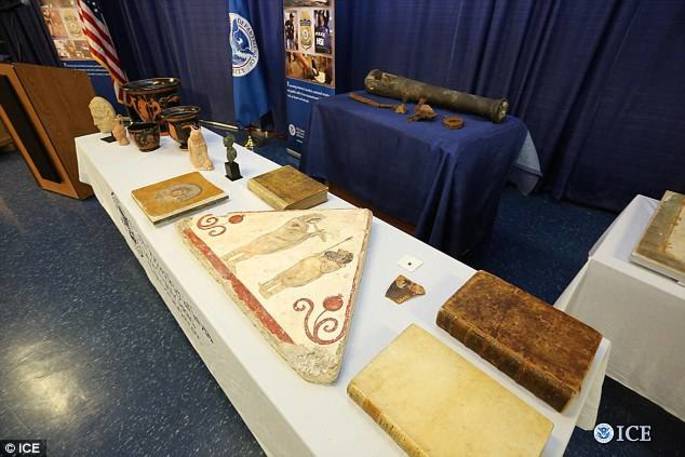


Three Pompeian frescoes – estimated at more than 30 million euros – had been smuggled into the US and ultimately came into the hands of a now deceased American businessman and were about to go to auction when they were intercepted by the carabinieri (the “Italian FBI”) unit for the protection of cultural heritage.
The frescoes, dating back to the 1st Century BCE, feature the portrait of a woman with a baby cupid, a woman in red, and the figure of a man. They were part of a bigger set that had been stolen from an archaeological dig back in 1957.
The carabinieri also recovered other illegally trafficked pieces including a second-century AD white marble “sleeping beauty”, a pinnacle from a tomb from the ancient Greek city of Paestum near Salerno, dating to the third or fourth century BCE, and an Etruscan “kalpis” decorated by the famed Micali painter (510-500 BCE) voluntarily given back by the Toledo Museum in Ohio [2].
After a probe involving the US Homeland Security Investigations [3] and Immigration and Customs Enforcement [4] agencies, it has been agreed that these and other pieces will be returned to their original sites or to close-by museums. This is undoubtedly great news, however, as US Ambassador to Italy John R. Phillips [5] remarked "What has been returned today is just a fraction of the works currently illegally circulating on the market”.
Dario Franceschini [6], the minister of Italian Culture, also commented on the events, and reminded everyone of the importance of protecting our cultural heritage, which is subject to plundering and theft and can easily be lost in the midst of the complex networks that constitute the international art market.
The minister also mentioned another form of threat that has been a great cause of concern lately: the threat of destruction by extremist terrorist groups like ISIS, who last March, bombed the ancient archeological sites in Syria and Iraq, destroying irreplaceable parts of the world’s cultural heritage. "It is ever more urgent for the international community to mobilize in organized prevention” He stated.
Both Italy and the US seem to be on the right path, as the smooth resolution of this episode suggests. However, there is still much to be done in terms of conveying the importance of preserving cultural heritage, preventing such thefts, and establishing appropriate sanctions for committing them.
In fact, as it often happens in these cases, no one was arrested for the theft of these artworks. This because of a lack in fitting laws and regulations that apply across borders and throughout the years. This is why the Italian Ministry of Culture is currently working with the Justice Ministry on drafting a bill to redefine the entire subject of cultural heritage, tomb raiding, smuggling and related crimes.
Source URL: http://iitaly.org/magazine/focus/facts-stories/article/three-stolen-pompeii-frescoes-found-in-us-be-returned
Links
[1] http://iitaly.org/files/rubati1432779739jpg
[2] http://www.toledomuseum.org/
[3] http://www.ice.gov/hsi
[4] http://www.ice.gov/
[5] http://en.wikipedia.org/wiki/John_R._Phillips_%28attorney%29
[6] http://en.wikipedia.org/wiki/Dario_Franceschini